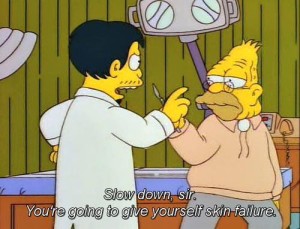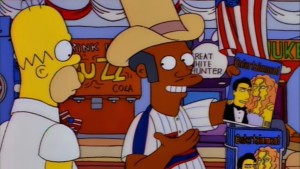(Make sure you read part one & part two) It’s been over twenty years since I can remember the first time I saw Matt Groening’s “crudely drawn” family of five deal with the almost surreal problems that life seemingly presents on a daily basis. From that moment I laid my eyes on “The Simpsons” I became enamored and, eventually, a life-long fan (more than likely I’ll be re-watching episodes when I’m old enough to shout at clouds). During my time as a “Simpsons” viewer I’ve discovered many relatable life lessons that I plan to share with you. Welcome to “The Simpsons Life Lesson” series (season seven – part three).
Sometimes a Lie is Better Than the Truth (Episode 16 – “Lisa the Iconoclast”)
Springfield’s bicentennial was only a week away when Lisa Simpson’s class was given the duty of writing essays about their town. Lisa took her research beyond the typical realms of libraries and textbooks, visiting the local historical society. It was during her trips through the world of edu-tainment that Lisa discovered the darkest of dark secrets: the man responsible for the birth of Springfield, Jebediah Springfield, was a murderous pirate who attempted to kill George Washington (accidentally tearing apart the first United States President’s painted portrait done by Gilbert Stuart).
Of course no one but her father believed Lisa, including her teacher who gave the girl a failing grade for her lacking research and “PC Thug” antics. Joining Lisa in her crusade was her supportive dad – who had become the town’s crier for the bicentennial parade. Though she was telling the truth and found evidence everywhere, forces beyond her control were going out of their way to make sure no knew about the person once known as “Hans Sprungfeld”. Well, the “forces” was actually a single force that so happened to be the town’s sole historian, Hollis Hurlbut. Seeing the error of his ways when it came to tinkering and ignoring history, Hurlbut finally teamed with Lisa to expose Jebediah for all of his villainy. Staring into the sea of follow Springfield natives dressed as their hero and inspired by his “patriotic” ways, Lisa realized the truth behind Springfield’s origin and its founder would destroy the very societal, mental, and maybe even physical foundation of her hometown. The burden of knowledge was something Lisa could carry in an effort to preserve positive qualities a pirate like Hans could never impart. Lisa truly understood that a noble spirit embiggens the smallest man; and a lie that spawns goodness might be more beneficial than the truth ever could.
There’s Always Something Going on in Your Town (Episode 21 – “22 Short Films About Springfield”)
It was an average day of vandalism and child-like wonderment for Bart and his best friend Milhouse when the youngest Simpson male posed the question of whether or not something actually happens in his town beyond what they can see. Though Bart doesn’t physically see everything going on in Springfield, his query set off a chain of events for the viewer that essentially became a series of short skits featuring various characters in the town (though he did play a part in Lisa’s episode-long situation featuring the tiring removal of her brother’s thrown gum from her hair). The cast of characters involved in Springfield’s seemingly daily absurdity included Dr. Nick Riviera – who was on the verge of being sued for performing surgeries with a knife and fork from the local seafood restaurant and stealing cadavers for the car pool lane – saved “Grandpa” Abraham Simpson from “bonus eruptus”, actor Bumblebee Man’s life imitating his penchant for chaotic, destructive art for the sake of humor, and Reverend Lovejoy urging his pet to poop on the lawn of Springfield’s biggest Bible thumper, Ned Flanders.
So whenever you feel like your town is dull and lifeless, just walk for a few minutes. You might find anything from a giant man making an adolescent antagonist walk down the street with his shorts down by his ankles while everyone finally laughs at him, a slack-jawed yokel yelling to his mom from a telephone pole, or moments reminiscent of Quentin Tarantino’s “Pulp Fiction” playing out thanks to the actions of an incompetent cop and a boy looking to not urinate on himself.
Be Yourself (Episode 23 – “Much Apu About Nothing”; Episode 24: – “Homerpalooza”; Episode 25 – “Summer of 4 Ft. 2”)
Who knew a little brown bear could initiate an argument about high taxes and illegal immigrants. In an effort to pacify an angry mob of townspeople, Mayor Quimby blamed rising taxes to pay for the “bear patrol” program his supporters demanded when a single bear decided to take a stroll through the streets of Springfield (bringing harm to nothing but mailboxes and trashcans). Homer, in favor of potential referendum Proposition 24 that would see the deportation of illegal immigrants, soon found out that his favorite convenience store worker Apu Nahasapeemapetilon was an illegal immigrant. Apu would reach the greatest levels of desperation after harassment and protesting outside of the Kwik-E-Mart hindered his business, forcing him to purchase fake U.S. citizenship documents including his death certificate. Pretending to be full-blooded American, Apu denied his Indian heritage and religious beliefs. The dead eyes of Tom Cruise and Nicole Kidman on the cover of “Entertainment Weekly” finally snapped Apu into reality; motivating Homer to help his friend pass the U.S. citizenship test. Apu passed (mostly by ignoring every piece of knowledge Homer tried to bestow) and was officially a citizen that could embrace his life, heritage and unaltered accent.
Homer became the next episode’s focus, discovering his age had caused musical stagnation (and many other things kids couldn’t relate to like sassing the word “jive”) in his life. To get “with it” again, Homer decided to let his kids skip school for the day to witness the biggest musical festival ever, “Hullabalooza”. Just when it seemed Homer was out of his element he found out that his body featured his stomach having the ability to take cannonball-like shots by items such as inflatable pigs … and actual cannonballs. Homer became “Hullabalooza’s” latest marquee freak, gaining notoriety from Generation Xers, respect from his children (becoming the man Bart most admired) and knowledge of mainstream bands that became synonymous with the 20th century’s final decade including Cypress Hill, Sonic Youth and The Smashing Pumpkins (oh, and Peter Frampton was in there, too).
Eventually, Homer had to make a choice after the cannonball shots started doing irreparable damage to his abdomen: Give up the life of a sideshow freak, or go down in a blaze of glory after taking one more cannonball to the stomach in front of his hometown friends and family. Homer had grown to love the “cool guy & heroic” image associated with his act, but to be a dad proved to be more important than anything. Jumping off stage, Homer disregarded his popularity to embrace the person he had become – a father varying in his efforts between good and bad to provide for his family.
But no episode better represented the trifecta of self-acknowledgement than the season finale, “Summer of 4 Ft. 2” (one of, if not my favorite “The Simpsons” season finales ever). Brainiac Lisa Simpson found herself in the awkward position of having no friends in or out of school. When the Simpson family had an opportunity to spend their summer vacation at Ned Flanders’ beach house in Little Pwagmattasquarmsettport. Realizing being herself hadn’t be socially profitable over her eight years of existence, Lisa opted to transform herself from nerdy geek to hip circa-1990s slacker (topped by a sideways cap, fashionably cut jean shorts, a retro tie-dye shirt, and a bleak attitude about life).
Seeing his sister attain friends by essentially imitating him caused Bart to expose Lisa for being everything she pretended not to be for two short weeks in a place she might never visit again. Though Bart’s plan to showcase Lisa for being a phony “cool” kid worked, the friends Lisa made gladly accepted her for being a truly good person – gluing a mural of seashells stating “Lisa Rules” onto family’s car before their leaving.
The best lesson to take away from the final three episodes of “The Simpsons” season seven is to be yourself. You might struggle to relate to your kids, find friends or even stay in the country you’ve called home for the past decade (or more), but you’ll at least be proud that you aren’t pretending to be someone that you’re not. And if you are better at being the fake version of yourself, just become that person and it’ll all work out for the best.














